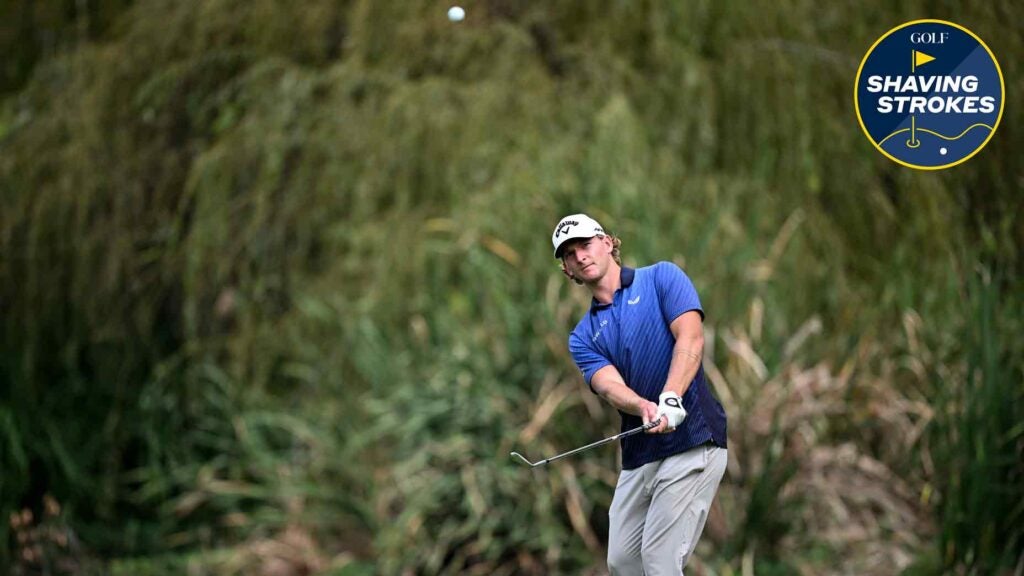Welcome to Shaving Strokes, a GOLF.com series in which we’re sharing improvements, learnings and takeaways from amateur golfers just like you — including some of the speed bumps and challenges they faced along the way.
Maybe it’s my own naivety, but I never really used the term “angle of attack” up until I took this job at GOLF last year. Then again, I’m just an average mid-handicapper as likely to skull a pitch as I am to hit it crispy.
But as I’ve become more dialed in as a player and continue to work toward breaking 80 for the first time, I’ve realized how important it is to understand what angle of attack actually means.
Many of you reading this may be in a similar place and have no clue why your attack angle is either leading to good or bad outcomes. To help explain what attack angle is and how to use it correctly, GOLF Top 100 Teacher Joey Wuertemberger provides a crash course to master it. Take a look below to see why (and how) to determine whether you should be shallow or steep on a certain shot.
Steep vs. shallow — understanding angle of attack
Although many recreational golfers often obsess over power, speed and distance, Wuertemberger has a reminder for them — focus on finesse and precision instead.
“Most casual players can quickly improve by understanding how hyper-focused pros are about dialing in their precision versus trying to overpower everything,” he tells me. “One critical element to develop a proficient game is knowing about the angle of attack, and whether you need to be shallow or steep.
“When a player understands this, it will drastically improve their scores.”
But why is it so important to understand which angle of attack you should use? Simply put, it’s so you give yourself a better opportunity at success.
“Angle of attack is the vertical path that your clubhead travels before impacting the ball,” Wuertemberger says. “It influences both the spin and trajectory of a shot, which, in turn, effects both distance and accuracy. A shallower angle decreases spin and creates a lower trajectory, while a steeper angle increases spin and creates a higher trajectory.
Next, Wuertemberger describes the types of shots you should use a shallow angle versus a steeper angle.
“When your clubhead approaches the ball on a shallower angle, this promotes more of a sweeping motion. Driver, fairway woods, hybrids, uphill lies, or even a ball sitting up in the rough are all types of shots where a shallow angle of attack is vital to promote the contact and ball flight needed,” he says. “A steeper angle of attack is more common with short irons, punch shots, hard pan lies, or balls sitting down in the rough. This steeper approach is pivotal for creating solid contact.”
Now that you understand some basics about attack angle, here are the three keys Wuertemberger says are most important in order to control it.
Setup positions
For a shallower club path, move the ball up in your stance (like you would when teeing up your drive). This allows the swing to flatten out, producing the low-spin trajectory that you want. Conversely, to achieve a steeper angle of attack, position the ball closer to your trail foot (like a punch shot or low chip), which allows for a descending blow into the ball.
Weight distribution
For a shallow angle of attack, keep your weight evenly distributed throughout the swing. For a steeper attack angle, be more aggressive with your weight by shifting it more to the lead side all the way through impact.
Wrist angles
On shots that require a shallow angle of attack, use less wrist hinge on the backswing and finish your swing with more of a passive release. But when you’re faced with a buried ball, hard pan lies, or when you need to flight a shot lower, you’ll need to set your wrists on a steeper angle off the initial takeaway — focusing on getting to your lead side.
Remember, mastering your angle of attack requires practice. But by spending time on the range experimenting with different ball positions, lies, weight distributions, and wrist angles, you can better understand it and apply it to your upcoming rounds.
“It’s extremely important to understand which angle of attack you need and in which situations,” Wuertemberger adds. “But I promise that, by using the three keys above, you’ll soon become a master in attack angles; which will lead to better shots and lower scores.”
